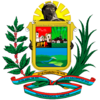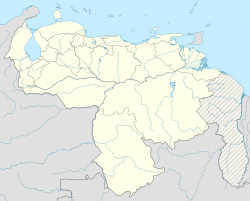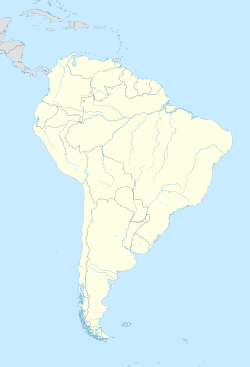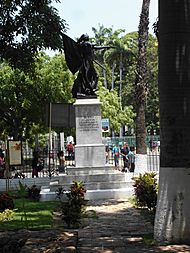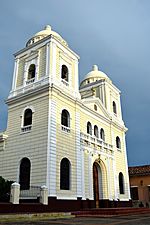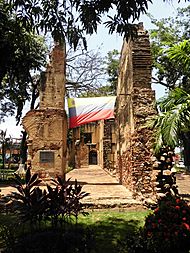Barcelona, Venezuela facts for kids
Quick facts for kids
Barcelona
|
|||
|---|---|---|---|
|
City
|
|||
| Nueva Barcelona del Cerro Santo | |||
|
Panoramic of the city and El Morro hill.
|
|||
|
|||
| Country | |||
| State | Anzoátegui | ||
| Municipality | Simón Bolívar, Anzoátegui | ||
| Founded | 1671 | ||
| Area | |||
| • Total | 76.5 km2 (29.5 sq mi) | ||
| Elevation | 13 m (43 ft) | ||
| Population
(2022)
|
|||
| • Total | 815,141 | ||
| • Density | 10,655/km2 (27,597/sq mi) | ||
| Demonym(s) | Barcelonés/a | ||
| Time zone | UTC−4 (VET) | ||
| Postal Code |
6001
|
||
| Area code(s) | 0281 | ||
| Climate | BSh | ||
Barcelona is the capital city of Anzoátegui State in Venezuela. It was founded in 1671.
This city, along with Puerto La Cruz, Lecheria, and Guanta, forms a very important urban area in Venezuela. About 950,000 people live in this larger area.
Contents
History
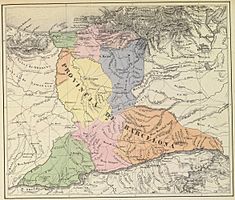
Spanish Colonization
Unlike some newer cities, Barcelona has a mix of old and new buildings. This shows its long history. The city was first started by a Spanish explorer named Joan Orpí in 1638. It was called Nueva Barcelona del Cerro Santo, which means "New Barcelona of the Holy Mountain."
Later, around 1671, the city was rebuilt a bit further away. This was done by governor Sancho Fernández de Angulo and a small group of settlers from Catalonia, Spain. Barcelona was part of a larger area called New Andalusia. One of the oldest buildings still standing is the Museo de Anzoátegui.
Many historical parts of Barcelona are around its main squares: Bolivar, Miranda, and Boyacá. Plaza Boyacá was the main center of the city. It's near the Iglesia El Carmen (Carmelite Church) and the city's main church, the Catedral de San Cristobal (Cathedral of Saint Christopher). This cathedral was built between 1748 and 1773. Today, it holds the remains of a saint named San Celestino.
Venezuelan Independence
After the King of Spain was forced to step down, people in the Americas wanted to rule themselves. In Venezuela, local governments started to form. On April 27, 1810, the people of Barcelona declared their independence from Spain. This led to a fight between those who wanted freedom and those who wanted to stay loyal to Spain.
On July 5, 1811, Venezuela officially declared its independence. This started the Venezuelan Independence War. A building called La Casa Fuerte (The Strong House) became very important. It was an old convent that was turned into a fort by the people fighting for independence. They used it to protect the city from Spanish attacks. However, in 1817, Spanish forces attacked and destroyed the house, killing everyone inside.
After the war, Barcelona became an important center again. Leaders like General José Antonio Páez and Antonio Guzmán Blanco spent time there.
Geography
Barcelona is on the northern coast of Venezuela, in Anzoátegui State. It's close to mountains. The northern coast has many beautiful beaches like Isla de Plata, Conoma, and Playa Mansa. These beaches are popular with tourists and local people.
Barcelona is also a gateway to the Mochima National Park. This park is a protected area with many islands and small islands along the coast.
The city has a river called the Neverí River. It flows through the center of Barcelona. Sometimes, the river used to flood. In 1972, canals were built to help control the water levels. The Aragua River also flows near the city and has caused floods in the past.
Climate
Barcelona has a hot, semi-dry climate. It has a wet season from June to September and a dry season from December to April. It doesn't get a lot of rain because of its location near the southern Caribbean Sea.
City Life
Over time, Barcelona grew into an important city for business and trade. It has expanded and now connects with other nearby cities, especially those focused on tourism.
One famous area is El Morro, a tourism complex. It has many canals built for homes, hotels, and marinas. This allows many buildings to have direct access to the sea. A large shopping center called Centro Comercial Plaza Mayor is also nearby. It's built in a colorful style, similar to buildings in the Dutch Caribbean.
Transport
The main airport in the area is Generál José Antonio Anzoátegui International Airport. You can fly from here to Panama, other parts of Venezuela, and to the capital city, Caracas.
Besides buses that travel throughout Anzoátegui State, you can also take boats to nearby islands like Las Chimanas and Cachicamo. There's also a ferry that goes to Margarita Island.
Places of interest
The Barcelona area has many historic places that show what life was like in the past. The city has been important in many battles between the Spanish and native people during its colonization. It also has a strong religious history.
Many of these sites, like monuments, museums, and churches, are still well-preserved. They offer visitors a lot of information about the area's history.
- Cathedral of San Cristóbal of Barcelona: This church was started in 1748 but was damaged by an earthquake. It was finally finished in 1773. A special feature is that under the main altar, there's a container with a bone from each of seven saints. In 1777, the remains of a martyr named St. Celestino were brought to the church from Rome. They are kept in a special chapel. St. Celestino is now a patron saint of Barcelona, and his celebrations are held on May 3rd and 4th each year.
- Casa de la Cultura: This is a restored old colonial house. It has a permanent art exhibition of works by famous Venezuelan painters on its second floor.
- Basílica del Cristo de Jose: Also known as "El Cristo de los Viajeros" (The Christ of Travelers), this church is a place where people go to pray for protection during their journeys.
- Casa Fuerte de Barcelona: This building was once a Franciscan convent. It was turned into a fort by General Pedro María Freites and Santiago Mariño to protect the people from Spanish attacks in 1817. Sadly, the fort was attacked, and many people inside were killed. The ruins now serve as a reminder of that event.
- Plaza Boyacá: Since 1897, this has been the city's main square. It's named after an important battle won by General José Antonio Anzoátegui, whose statue stands in the center. This plaza has looked much the same since it was built in 1671.
- Plaza Bolívar: This public square honors General Simon Bolivar, a key leader in Venezuela's fight for independence.
- Plaza Miranda
- Theater Cajigal: This is a beautiful theater built in the 1800s in a classical style. It's small and can hold about 300 people. Many plays and concerts are held here.
- Tradition Museum: Built in 1671, this is one of Barcelona's oldest houses. It looks just like a Venezuelan colonial home. In the past, it had access to the Neverí River, serving as a dock for boats. The museum has over 400 items, including native crafts, sculptures, and religious art from the 16th century.
- Plaza de La Raza
- Royal Bridge of the Spaniards: This is an old stone bridge with arches, built in the colonial style.
- Antigua Aduana: These are the remains of what was once a very important customs house in Venezuela during colonial times. For over two centuries, it was a busy trading port. Today, only memories remain, and the area is covered by mangrove forests.
- Ruins of San Felipe Neri: The Iglesia de San Felipe Neri was founded in 1564. An earthquake in 1812 destroyed the church. Now, only its ruins remain, along with a grotto (a small cave-like shrine) to the Virgin Mary.
- The Shrine of Nuestra Señora del Carmen: This is one of Barcelona's most beautiful churches. Its construction faced many challenges due to wars and conflicts. It was officially opened in 1896, almost two centuries after it began. The church features fine marble floors and stunning Italian stained glass windows.
- Bolívar Bridge
- Naricual Hot Springs: These hot springs are located about 12 kilometers from Barcelona. The water is warm, between 40 and 50 degrees Celsius, and comes from a rock, forming a natural pool.
- Chimana holiday resorts: This is a beautiful coastal area with clear, shallow waters and sandy beaches. It's about 45 minutes by boat from Port Pamata Cualito and offers services like restaurants for visitors.
- Bergantín Resorts: This resort is in a lovely forest area with clear mountain water. Visitors can enjoy kiosks, restrooms, and food here. It's located about 64 kilometers southeast of Puerto La Cruz.
- Neverí River: This river starts in the mountains of Sucre state and flows for about 103 kilometers. It collects water from many smaller rivers and streams before emptying into the Caribbean Sea.
Education
Barcelona has many schools and universities. Here are some of the main ones:
- Universidad de Oriente – Núcleo Anzoátegui (UDO): This is the largest university in the area and well-known across Venezuela.
- National University of Tourism – Main Campus
- University Institute of Technology "General Pedro María Freites"
- Universidad Central de Venezuela (UCV) – Regional Center Barcelona
- Universidad Nacional Experimental Simón Rodríguez (UNESR)
- National Open University (UNA)
- Universidad Gran Mariscal de Ayacucho (UGMA) – Main Campus
- Universidad Santa María (USM) – Eastern Campus
- Instituto Universitario Politécnico Santiago Mariño (IUPSM) – Main Campus
Sports
Basketball
Barcelona is home to the professional basketball team Marinos de Anzoátegui. They have won the Venezuelan Professional Basketball League 11 times! They play at the Polideportivo Simón Bolívar, also known as La Caldera del Diablo, which can hold 5,500 fans.
Soccer
The city has the José Antonio Anzoátegui Stadium, which can hold 40,000 fans. This stadium hosted games for the 2007 Copa América and the 2009 South American U-20 Championship. Venezuela's soccer team, Deportivo Anzoátegui, plays its home games here.
International relations
Barcelona is connected to other cities around the world. These are called "twin cities":
Notable people
Some famous people from Barcelona include:
- Ángel Mottola
- Jacob Baiz
- Cayaurima
- Cumanagoto
- Diego Bautista Urbaneja
- Eulalia Ramos Sánchez de Chamberlain (Eulalia Buroz)
- Joan Orpí i del Pou
- José Antonio Anzoátegui
- Juan Manuel Cajigal
- Eulalia Ramos
- Miguel Otero Silva
- Pedro María Freites
- Ryan Vasquez, Singer, songwriter
- Willians Astudillo, baseball player
- Víctor Reyes, baseball player
Images for kids
See also
 In Spanish: Barcelona (Venezuela) para niños
In Spanish: Barcelona (Venezuela) para niños




